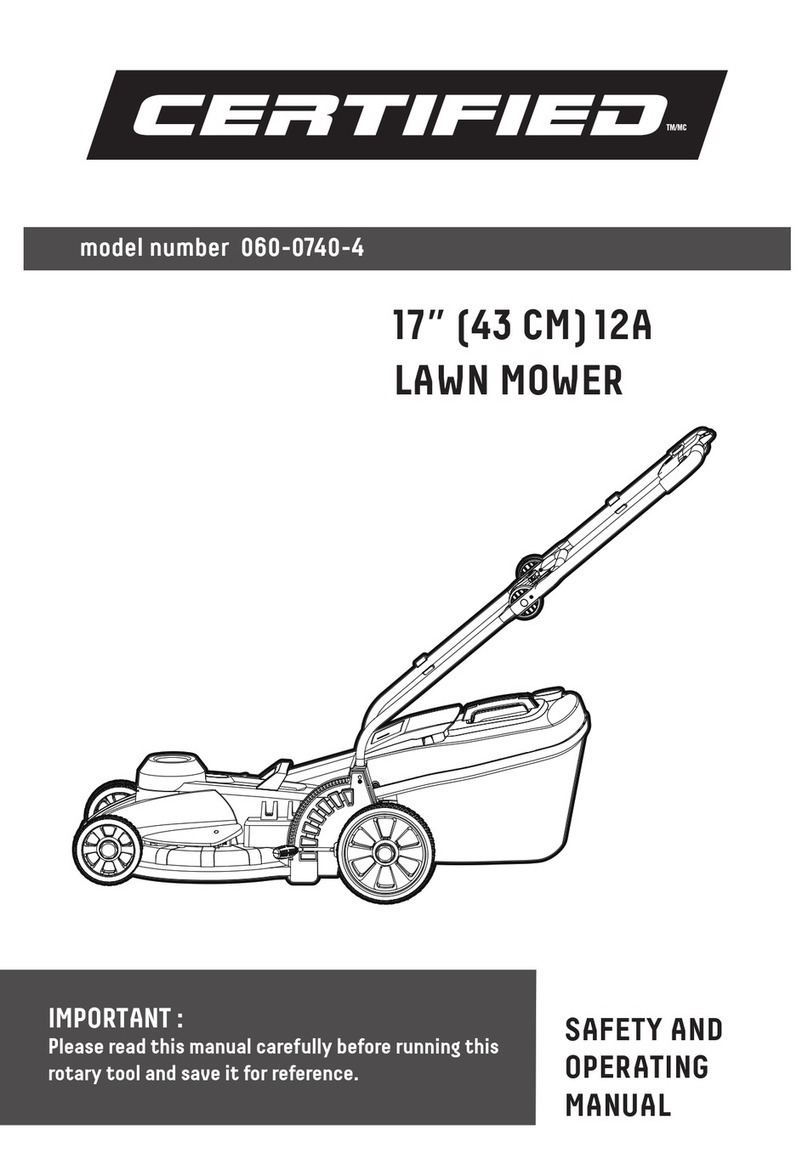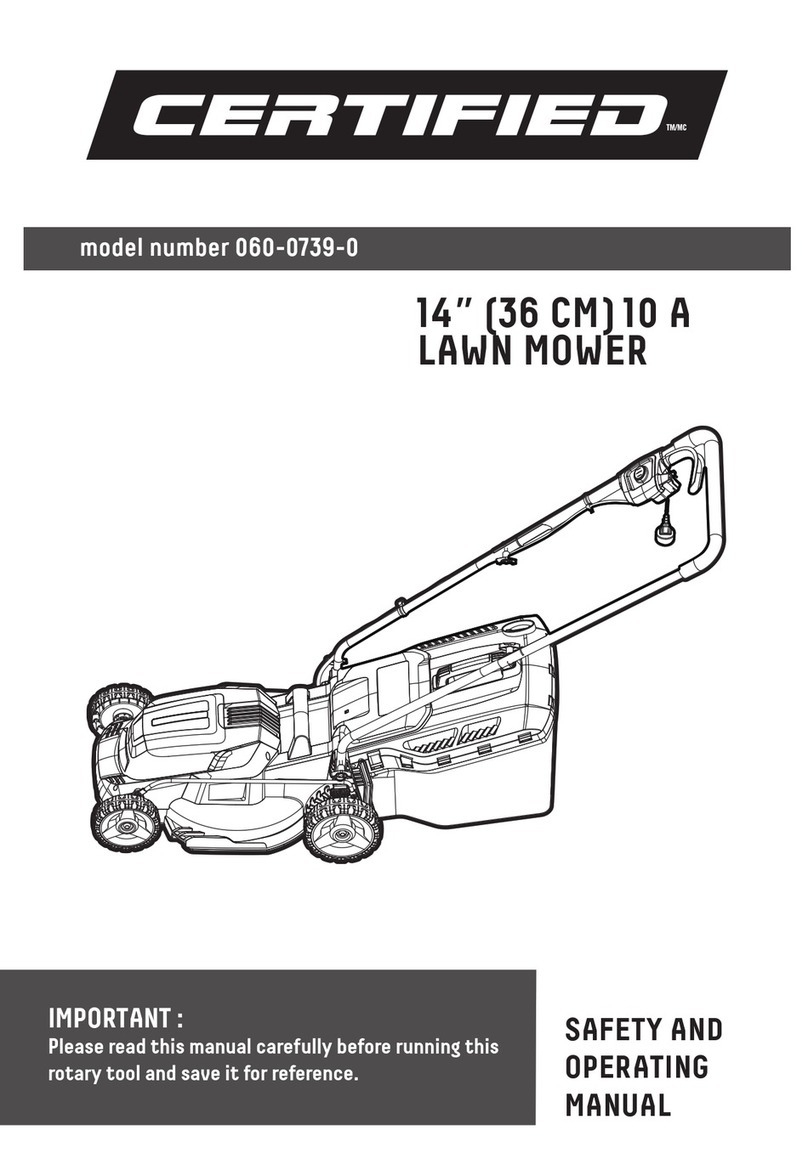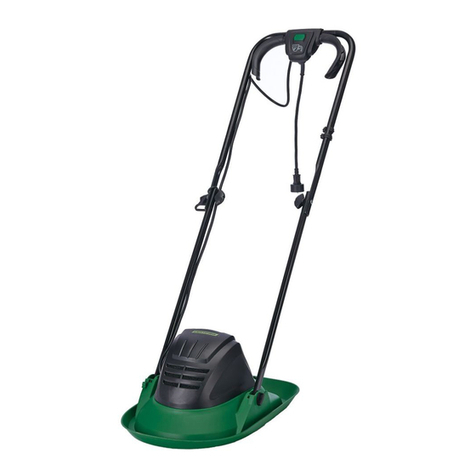model no. 054-8289-8
8
ASSEMBLY INSTRUCTIONS
INSTALLING THE SAW BLADE (Fig. 1)
1. Unplug the jigsaw from the power supply.
2. Turn the tool upside down and open the
protection guard by pulling it downward.
3. Loosen the hex screws on the blade clamp
with the hex key, which is stored at the base
of the power cord.
4. Insert the blade into the locating groove in
the blade clamp. The back of the blade must
rest in the groove in the guide roller.
5. Tighten the hex screws to lock the blade. Pull on the blade to check that it is securely
locked in place.
REMOVING THE SAW BLADE (Fig. 1)
1. Unplug the jigsaw from the power supply.
2. Open the protection guard by pulling it downward.
3. Turn the tool upside down and loosen the hex screws on the blade clamp with the hex
key.
4. Remove the blade by pulling it out from the base of the jigsaw.
ASSEMBLY INSTRUCTIONS
Fig. 1
Protection
guard
CAUTION!
• When changing the blade, always wear protective gloves. The sharp edge of the blade can cause
personal injury. The blade can be very hot after working.
• Allow the blade to cool after use. The blade can be dangerously hot.
WARNING!
• Check to see if the blade is correctly fastened. An incorrect or insecurely fastened blade can
become loose during operation and cause a hazard.
• Always ensure that the tool is turned OFF and unplugged from the power supply before making any
adjustments and installing any attachments.
NOTE:
• If the blade cannot rest in the groove of the blade clamp, check the section
ADJUSTING THE BASE PLATE FOR
BEVEL CUTTING below.
• Use only with “T” and “U” shank jigsaw blades.
Safety instructions
Safe Practices for Pedestrian-controlled
Mowers
This cutting machine is capable of amputat-
ing hands and feet and throwing objects.
Failure to observe the following safety
instructions could result in serious injury or
death.
I. GENERAL OPERATION
1. Read, understand, and follow all
instructions on the machine and in the
manual(s) before starting.
2. Do not put hands or feet near or under
the machine. Keep clear of the discharge
opening at all times.
3. Only allow responsible adults who are
familiar with the instructions to operate
this machine.
4. Clear the area of objects such as rocks,
wire, toys, etc., which could be thrown by
the blade. Stay behind the handle when
the engine (motor) is running.
5. Be sure the area is clear of bystanders
before operating. Stop machine if anyone
enters the area.
6. Do not operate machine barefooted or
while wearing sandals. Always wear
substantial footwear.
7. Do not pull machine backward unless
absolutely necessary. Always look down
and behind before and while moving
backward.
8. Never direct discharged material toward
anyone. Avoid discharging material
against a wall or obstruction. Material
may ricochet back toward the operator.
Stop the blade when crossing gravel
surfaces.
9. Do not operate machine without the
entire grass catcher, discharge guard,
rear guard, or other safety protective
devices in place and working.
10. Never leave a running machine unattend-
ed.
11. Stop the engine (motor) and wait until the
blade comes to a complete stop before
cleaning the machine, removing grass
catcher, or unclogging the discharge
guard.
12. Operate machine only in daylight or good
artificial light.
13. Do not operate machine while under the
influence of alcohol or drugs.
14. Never operate mower in wet grass. Always
be sure of your footing; walk, never run.
15. Disengage the drive system, if so
equipped, before starting the engine
(motor).
16. If the machine should start to vibrate
abnormally, stop the engine (motor) and
check for the cause immediately.
Vibration is generally a warning of
trouble.
17. Always wear eye protection when
operating machine.
18. See manufacturer’s instructions for
proper operation and installation of
accessories. Only use accessories
approved by the manufacturer.
II. SLOPE OPERATION
Slopes are a major factor related to slip and
fall accidents, which can result in severe
injury. Operation on all slopes requires extra
caution. If you feel uneasy on a slope, do not
mow it.
1. Mow across the face of slopes; never up
and down. Exercise extreme caution
when changing direction on slopes.
2. Watch for holes, ruts, bumps, rocks, or
other hidden objects. Uneven terrain
could cause a slip and fall accident. Tall
grass can hide obstacles.
3. Do not mow on wet grass or excessively
steep slopes. Poor footing could cause a
slip and fall accident.
4. Do not mow near drop offs, ditches, or
embankments. You could lose your
footing or balance.
III. CHILDREN
Tragic accidents can occur if the operator is
not alert to the presence of children. Children
are often attracted to the machine and the
mowing activity. Never assume that children
will remain where you last saw them.
1. Keep children out of the mowing area and
under the watchful care of a responsible
adult other than the operator.
2. Be alert and turn mower off if a child
enters the area.
3. Never allow children to operate the
machine.
4. Use extra care when approaching blind
corners, shrubs, trees, or other objects
that may block your view of a child.
IV. SERVICE
*SAFE HANDLING OF GASOLINE:
To avoid personal injury or property damage,
use extreme care in handling gasoline.
Gasoline is extremely flammable and the
vapours are explosive.
1. Extinguish all cigarettes, cigars, pipes,
and other sources of ignition.
2. Use only an approved gasoline container.
3. Never remove gas cap or add fuel with
the engine running.
4. Allow engine to cool before refueling.
5. Never refuel the machine indoors.
6. Never store the machine or fuel
container where there is an open flame,
spark, or pilot light such as on a water
heater or on other appliances.
7. Never fill containers inside a vehicle or on
a truck or trailer bed with a plastic liner.
Always place containers on the ground
away from your vehicle before filling.
8. Remove gas powered equipment from the
truck or trailer and refuel it on the
ground. If this is not possible, then refuel
such equipment with a portable
container, rather than from a gasoline
dispenser nozzle.
9. Keep the nozzle in contact with the rim
of the fuel tank or container opening at
all times until fueling is complete. Do not
use a nozzle lock open device.
10. If fuel is spilled on clothing, change
clothing immediately.
11. Never overfill fuel tank. Replace gas cap
and tighten securely.
GENERAL SERVICE
1. *Never operate machine in a closed area.
2. Keep all nuts and bolts tight to be sure
the equipment is in safe working
condition.
3. Never remove or tamper with safety
devices. Check their proper operation
regularly. Never do anything to interfere
with the intended function of a safety
device or to reduce the protection
provided by a safety device.
4. Keep machine free of grass, leaves, or
other debris build up. *Clean up oil or fuel
spillage and remove any fuel-soaked
debris. Allow machine to cool before
storing.
5. If you strike a foreign object, stop and
inspect the machine. Repair, if
necessary, before starting.
6. Never make any adjustments or repairs
with the engine (motor) running.
*Disconnect the spark plug wire and
ground against engine to prevent
unintended starting.
7. Always unplug electric mowers before
adjusting, cleaning, or repairing.
8. Check grass catcher components and
the discharge guard frequently and
replace with manufacturer’s recommend-
ed parts, when necessary.
9. Mower blades are sharp. Wrap the blade
or wear gloves, and use extra caution
when servicing them.
10. *Do not change engine governor setting
or over speed the engine.
11. Maintain or replace safety and instruc-
tion labels, as necessary.
* Asterisked items do not apply to
electric mowers.
Maintenance and storage
1. Keep all nuts, bolts and screws tight to
be sure the equipment is in safe working
condition.
2. Never store the equipment with gas in
the tank inside a building where fumes
can reach an open flame or spark.
3. Allow the engine to cool before storing in
any enclosure.
4. To reduce the fire hazard, keep the
engine, muffler, battery compartment
and gas storage area free of grass,
leaves, or excessive grease.
5. Check the grass catcher frequently for
wear or deterioration.
6. Replace worn or damaged parts for
safety.
7. If the fuel tank has to be drained, this
should be done outdoors.
8
SAFETY INFORMATION
model no. 060-0190-2
I
contact us: 1-844-428-7277


































